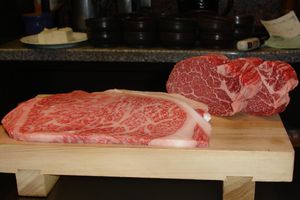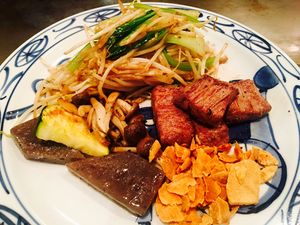كوبى بيف
Kobe beef (神戸ビーフ, Kōbe bīfu) هي اغيو تنبيه من تاجيما سلالة من اليابانية الأسود الماشية، في اليابان ل محافظة هيوغو وفقا للقواعد التي وضعتها كوبي تعزيز التسويق وجمعية تعزيز التوزيع. [1] اللحم هو الرقة، يكمن قيمته في نكهته، ، والدهنية ، وأيضا - رخامي الملمس. كوبي لحوم البقر يمكن أن تكون تسمي باسم ستيك، سوكيياكي ، شابو شابو ، الساشيمي و [ [تيبانياكي]] . يعتبر كوبي لحوم البقر عموما واحدا من أعلى العلامات التجارية الثلاث المعروفة باسم (SANDAI اغيو "، وتعزز عدد الثلاث الكبرى")، جنبا إلى جنب مع لحم البقر ماتسوساكا و OMI لحم البقر أو يونيزوا لحم البقر.
ويسمى كوبي أيضا Kobe niku (神戸肉, "Kobe meat"), Kobe-gyu (神戸牛) or Kobe-ushi (神戸牛, "Kobe cattle") in Japanese.[1]
. . . . . . . . . . . . . . . . . . . . . . . . . . . . . . . . . . . . . . . . . . . . . . . . . . . . . . . . . . . . . . . . . . . . . . . . . . . . . . . . . . . . . . . . . . . . . . . . . . . . . . . . . . . . . . . . . . . . . . . . . . . . . . . . . . . . . . . . . . . . . . . . . . . . . . . . . . . . . . . . . . . . . . . .
التاريخ
تم جلب الماشية الى اليابان من الصين في نفس الوقت مثل زراعة الأرز في حوالي القرن الثاني، فترة يايوي. [2] حتى حول وقت استعادة ميجي في عام 1868، كانت تستخدم فقط كما حيوانات الجر في الزراعة، الغابات، التعدين والنقل، وكما مصدر الأسمدة. كان استهلاك الحليب غير معروف، و- لأسباب ثقافية ودينية - لم تؤكل اللحوم.[3]:2[4][5]
تم عزل اليابان على نحو فعال عن بقية العالم من 1635 حتى 1854. لم يكن هناك إمكانية ولوج جينات أجنبية لقطعان الماشية خلال هذا الوقت. بين عام 1868، وهو عام استعادة ميجي، و 1887، تم استيراد بعض 2600 ماشية الخارجية، بما في ذلك Braunvieh، Shorthorn و ديڤون.[3]:8[6] بين حوالي 1900 و 1910 كان هناك نطاق واسع عبر تربية هذه مع الأسهم الأصلية. من عام 1919، مختلف متجانسة السكان في المنطقة التي نتجت عن هذه الفترة القصيرة من تم تسجيلهم عبر تربية و مختارة كما "ماشية اليابانية تحسين". وتميزت أربع سلالات منفصلة، تقوم أساسا على أي نوع من الماشية الأجنبية وأكثر ما أثر الهجين، وتم الاعتراف بها السلالات في عام 1944. وكانت هذه أربعة واگيو سلالة، والأسود الياباني، و البني الياباني، و المدقوق الياباني و قصير القرن الياباني.[3]:8[6] وتاجيما هي سلالة من الأسود الياباني، ومعظم سلالة من حيث عدد السكان (حوالي 90٪ من السلالات الأربع).[7][8]
Beef consumption remained low until after World War II. Kobe beef grew in popularity and extended its global reach in the 1980s and 1990s.[9]
In 1983, the Kobe Beef Marketing and Distribution Promotion Association was formed to define and promote the Kobe trademark. It sets standards for animals to be labeled as Kobe beef.[10]
In 2009, the USDA placed a ban on the import of all Japanese beef to prevent the Japan foot-and-mouth outbreak from reaching US shores. The ban was relaxed in August 2012. Shortly thereafter, Kobe beef was imported into the US for the first time.[11]
Industry
Kobe beef in Japan is a registered trademark of the Kobe Beef Marketing and Distribution Promotion Association (神戸肉流通推進協議会, Kōbeniku Ryūtsū Suishin Kyōgikai).[12] It must fulfill all the following conditions:[1]
- Tajima cattle born in Hyōgo Prefecture
- Farm feeding in Hyōgo Prefecture
- Bullock (steer or castrated bull)
- Processed at slaughterhouses in Kobe, Nishinomiya, Sanda, Kakogawa, or Himeji in Hyōgo Prefecture
- Marbling ratio, called BMS, of level 6 and above[13]
- Meat quality score of 4 or 5[13]
- Gross weight of beef from one animal is 470 kg or less.
The cattle are fed on grain fodder and brushed sometimes for setting fur.[14][15] The melting point of fat of Kobe beef (Tajima cattle) is lower than common beef fat.[16]
Kobe beef is expensive, as only about 3,000 head of cattle may qualify as Kobe.[6] As of March 2018, imported Kobe beef on sale in Harrods cost £625 per kilo.[17] In Japan, all cattle, not just those that end up as Kobe beef, can be tracked via a 10-digit number through every step of its entire life cycle.[18]
Kobe beef in other countries
Prior to 2012, Kobe beef was not exported. The first exports, in January 2012, were to Macau, then to Hong Kong in July 2012.[19] Since then, exports have also been made to the United States, Singapore, Thailand[20], the United Kingdom[21] and one chef in Canada.[22]
"Kobe-style" beef
The increase in popularity of Japanese beef in the United States has led to the creation of "Kobe-style" beef, taken from domestically raised Wagyu crossbred with Angus cattle, to meet the demand. Farms in the United States and Britain have attempted to replicate the Kobe traditions.[23] From the first Wagyu cattle imported in the 1970s, 150 US ranches now raise "tens of thousands of Wagyu cattle".[24]
The meat produced by these cross-breeds is different from the "authentic" Kobe beef, though this is "often by design", due to the perception that American palates do not actually want the richness of Japanese beef and would prefer a more familiar flavor profile.[7] Some US meat producers claim any differences between their less expensive "Kobe-style" beef and true Kobe beef are largely cosmetic.[25] Cuts of US "Kobe-style" beef tend to have darker meat and a bolder flavor.[26]
In Europe, UK grocery retailer Asda, owned by Walmart, introduced Wagyu beef at the end of 2011 under its Butcher’s Selection line using meat from a herd in Yorkshire, "bred from Holstein dairy cows impregnated with Wagyu semen". This not only made the beef more affordable, but it also resulted in less marbled meat more familiar to UK consumers.[4] In June 2014, the German discounter Aldi announced that it was going to introduce Wagyu beef steaks, "with every store receiving a limited number of 50 steaks, priced at a very competitive £6.99 for an 8-oz (225-g) sirloin and rib eye". However, Aldi’s Wagyu beef was sourced from New Zealand, where the exclusively grass-fed cattle are allowed to roam, more in keeping with changing standards of animal welfare (in Japan cattle are "confined in small pens and given much more energy-dense feed").[4]
Mislabelling
The proliferation of beef outside Japan marketed as Kobe beef is an issue for Kobe beef farmers. Due to a lack of legal recognition of the Kobe beef trademark in the United States, it is possible to sell meat that is incorrectly labeled as Kobe beef.[27][28] The Kobe Beef Marketing and Distribution Promotion Association planned to publish pamphlets about Kobe beef in foreign languages.[29]
Japan has a Wagyu Beef Export Promotion Committee.[7]
مرئيات
| تعليق الفيديو. |
انظر ايضا
المصادر
- ^ أ ب ت "Kobe Beef Marketing & Distribution Promotion Association Bylaws". Retrieved 30 September 2010.
- ^ خطأ استشهاد: وسم
<ref>غير صحيح؛ لا نص تم توفيره للمراجع المسماةأجرة - ^ أ ب ت Kiyoshi Namikawa (2016 [1992]). Breeding history of Japanese beef cattle and preservation of genetic resources as economic farm animals. Kyoto: Wagyu Registry Association. Accessed January 2017.
- ^ أ ب ت Simone Baroke (8 August 2014). "Japanese Wagyu Beef – Too Authentic?". Global Meat News.
- ^ Y., Grant (1 December 2008). "The Real Beef on Kobe Beef". Cheff Seattle.
- ^ أ ب ت Bennett, Steve. "History of Wagyu beef cattle breed in Japan". www.wagyuinternational.com. Retrieved 15 December 2017.
- ^ أ ب ت Jim Vorel (24 February 2015). "Adventures in Beef: A First-Time Taste of Authentic Japanese Wagyu". Paste.
- ^ Longworth, John W. (28 October 2004). "The History of Kobe Beef in Japan". Lucies Farm: Meat Digest.
- ^ Meghan Staley. "Kobe Beef". Trade Environment Database. American University. Archived from the original on 28 مارس 2015.
- ^ Krieger, Daniel (26 August 2010). "All for the love of Tajima cows". Japan Times.
- ^ Olmsted, Larry (7 January 2014). "The New Truth About Kobe Beef". Forbes.
- ^ "Kobe Beef Registered Trademarks". Retrieved 30 September 2010.
- ^ أ ب "Japanese Meat Grading" (PDF). Retrieved 3 August 2016.
- ^ Mail magazine entitled Kobe Merumaga Club 2 June 2002 issue by Kobe City Office
- ^ "edition September 19, 2007 issue". News Week Japanese. 19 سبتمبر 2007. Archived from the original on 26 أبريل 2009. Retrieved 16 مارس 2010.
- ^ Shin-Onsen town office. "Taste of Tajima-ushi" (in Japanese). Retrieved 6 September 2010.
{{cite news}}: CS1 maint: unrecognized language (link) - ^ Rayner, Jay (11 March 2018). "Farm Girl Café, Chelsea: 'We don't stay for dessert, because we have suffered enough' – restaurant review". The Guardian (in الإنجليزية). Retrieved 12 March 2018.
- ^ Yoshihisa, Godo. "The Beef Traceability System in Japan". FFTC Agricultural Policy Platform. Retrieved 15 December 2017.
- ^ Jason Chow (27 July 2012). "Kobe Beef Arrives in Hong Kong". Wall Street Journal.
- ^ "Kobe Beef Marketing and Distribution Information".
- ^ Rayner, Jay (11 March 2018). "Farm Girl Café, Chelsea: 'We don't stay for dessert, because we have suffered enough' – restaurant review". The Guardian (in الإنجليزية). Retrieved 12 March 2018.
- ^ "If you think you've had Kobe beef in Canada, you're wrong. But here's your chance".
- ^ "Cattle on 40 pints a day of beer". BBC News. 9 February 2007.
- ^ J.C. Reid (13 March 2015). "American Wagyu and the myth of Kobe beef". Houston Chronicle.
- ^ "American Kobe-style beef replaces the real thing". Associated Press. 29 December 2005. Retrieved 4 January 2013.
- ^ Sayet, Jackie (6 October 2009). "Bogus beef: Miami restaurants say it's Kobe, but it's not". Miami New Times.
- ^ Olmstead, Larry (12 April 2012). "Food's Biggest Scam: The Great Kobe Beef Lie". Forbes.
- ^ Olmstead, Larry (7 January 2014). "Food's Biggest Scam, Part 2: "Domestic" Kobe And Wagyu Beef". Forbes.
- ^ Yomiuri Shimbun (19 July 2008). "Kobe beef — Correct information for foreign countries" (in Japanese). Archived from the original on 18 October 2008. Retrieved 20 July 2008.
{{cite web}}: CS1 maint: unrecognized language (link)
<ref> ذو الاسم "cabi" المُعرّف في <references> غير مستخدم في النص السابق.
